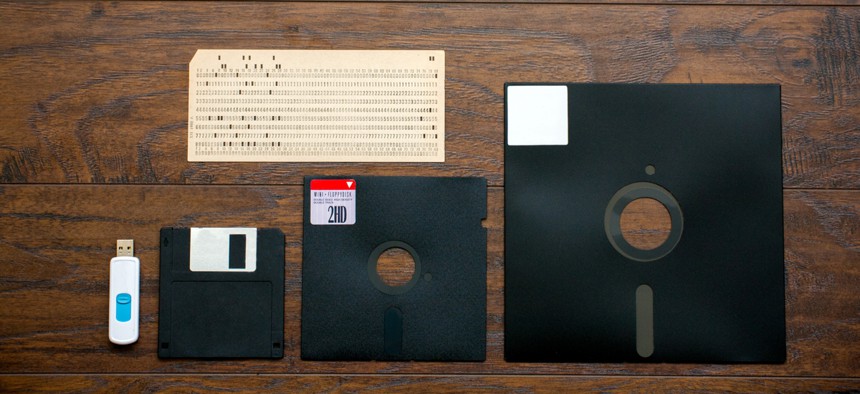Learning from New Jersey: Why Government Organizations Should Cut Ties with COBOL

Max D Solomko/Shutterstock.com
COBOL is an aging programming language and its workforce is no different.
In the wake of COVID-19, our world has been upended. From the indefinite closures of all nonessential businesses to a mass shift to remote work and stay-at-home orders, the spread of the virus has interrupted the core functions of our society—and even shed light on critical IT issues within our government.
The system that powers the state of New Jersey’s unemployment benefits exists on a COBOL-based mainframe that’s over 40 years old. Following a dramatic increase in applications for unemployment that overwhelmed systems, the state put out a call for COBOL programmers to help them get these unemployment services up and running. However, New Jersey’s approach is simply putting a bandage over a much larger issue.
Government organizations are no strangers to technological issues on both the state and federal level. In 2018, the IRS computer system responsible for processing millions of returns crashed on tax day despite repeated warnings from officials that these systems were out of date. Many of these organizations are also running on systems programmed with COBOL and hesitate to modernize their technologies in fear of downtime or taking their systems being offline entirely. However, these organizations can break away from their legacy mainframes while still allowing these systems to produce their core functions—and the solution isn’t to hire more COBOL developers.
Selecting a Modernization Strategy
COBOL is an aging programming language and its workforce is no different. As COBOL developers retire, they take with them years of essential knowledge and road mapping for the overall functionality of a specific system. As a result, hiring a new wave of COBOL developers won’t do much for an organization, as managing these systems requires extensive knowledge about the application itself rather than the code in which it is written.
Using Third-Party Solutions
One way that government organizations can modernize their aging legacy systems is to utilize a third-party, off-the-shelf solution. This process enables an organization to replace its technologies with components available from an outside source, thus significantly reducing the level of hands-on maintenance required for handling source code, production bugs, enhancements and more. However, this approach is one of the most expensive modernization strategies—and once the vendor’s code is changed and personalized, it’s no longer supported by the vendor. This can make any further updates, bug fixes or other enhancements significantly more complicated to pursue.
Replatforming
Another approach to modernization is known as replatforming, or “rehosting” a system on a distributed platform. This approach is a low cost and fairly low-risk strategy to maintain the business value of an aging operating environment while reducing the overall operational costs. This approach emulates the legacy operating environment on a new platform, but retains the legacy COBOL code-as is. As a result, organizations that pursue this approach will find themselves faced with the same challenge of finding COBOL developers to continue to maintain it—acting against the motivating factors for modernizing in the first place.
Application Re-Engineering
While sometimes necessary, application re-engineering requires an organization to recreate their legacy system’s functionality on newly written applications – requiring them to capture, code, test, debug and refine its code throughout a lengthy adjustment cycle. This process can not only inconvenience end users but many analysts report the failure rate of this approach to be between 70-80%. Few entities to pursue this path.
Automated COBOL Conversions
The most effective long-term solution for government organizations is pursuing an automated COBOL conversion. This approach lets organizations preserve the functionalities of a system by creating a 100% like-for-like copy of the system, but in a maintainable programming language like C# and Java. This not only preserves essential business logic but allows for businesses to better integrate and personalize its functions while opening themselves up to a breadth of scalable resources and system support. By recreating the system in a line-for-line format, automated conversions are an essential tactic for entities that need to preserve business logic and processes.
Putting Their Best Foot Forward
The older a system is, the higher the security risk it creates for organizations. There is no doubt that many organizations need to take the plunge and begin modernizing their systems but it shouldn’t take a pandemic to initiate this change. Rather, government entities should use the struggles of New Jersey and other states as a motivating factor to conduct a technical evaluation of their systems to determine if they are still adequately capable of meeting modern demands, or if their mainframes should we swapped out with more current technologies better suited for carrying out core functions. Through this process, government organizations will be better positioned to lay the foundation of their plans to update their processes and ensure success—or risk facing the same consequences as the entities that waited to address them.
Cameron Jenkins is executive vice president of Modern Systems—an Advanced company.





